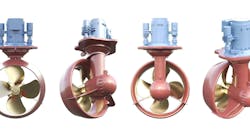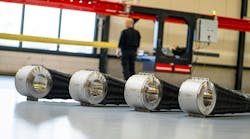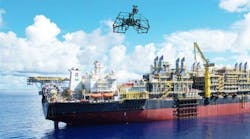Thorbjörn Friman
Lidan Engineering
Drilling contractors are becoming more demanding about safety in drawworks control, in particular the control philosophy and safety features of the brake system. The majority of offshore drilling rigs are equipped with electrical motor-driven National Oilwell drawworks, with the traditional band brake as primary brake system and the Baylor eddy current brake system as secondary. While the Baylor brake, governed by a small electric controller, is for braking dynamic forces at high speed, the band brake is applied for the final slow-down to full stop and precision control at creep speeds.
null
The drawworks band brake is operated mechanically by a 5-ft long solid steel bar for braking and holding weights normally of 200-300 tons, but up to 500 tons for certain operations such as handling the BOP. To generate the necessary braking force on the drum, the driller needs to repeatedly apply considerable manual power onto the brake lever, sometimes to the maximum that his body weight can withstand. The consequent physical strain can lead not only to severe injuries and fatigue, but it may also divert the driller's attention away from other control functions. Another potential risk is the crown block server, which often unexpectedly triggers a compressed air cylinder, connected to the brake shaft, which in turn strikes down the brake lever violently and is known to not seldom hit the driller.
Brake servo
A servo brake system greatly reduces the driller's workload and risk exposure. The mechanical brake lever is increasingly being replaced with a small servo-brake handle equivalent in size to the Baylor handle. However, the introduction of a servo system adds one further link between the operator's hand and the band brake mechanism. This may cause the driller to lose some of his direct contact with the string load.
Lidan Engineering, which has solid experience in upgrading drawworks of the band brake type, has designed its DBS servo to mimic where possible the driller's habitual braking technique, as well as preserving the prevailing brake control philosophy. The DBS handle is controlled in a nearly identical fashion to that employed for the conventional brake lever. In addition, the analogue property of the brake handle is designed with a logarithmic resolution control – so the lower the speed and the higher the load, the more sensitivity in the handle. This feature makes it easy to identify the "sweet spot" where the load and the friction counter force reach equilibrium. The increased resolution is concentrated especially at this point, which in turn brings greater precision at creep speed and "direct feeling" of "load in hand."
Dual actuators
The DBS servo handle governs an active type brake actuator, working on a brake arm on the drawworks brake shaft. For safety, a second passive, fail-safe type brake actuator with a set of disc springs, charged by the servo-pressure, stands by to trigger its spring force on the same brake arm as the active actuator. A sequential load-sharing function between the two actuators prevents undesired brake reinforcement.
Improved vision
The servo control is delivered normally as a single unit pedestal-type console. Alternatively, it may be integrated with the main panel in the driller's cabin. Along with improved ergonomics, drillers are typically requesting control chairs that are designed either to carry the control consoles on the chair itself, or to remain on fixed pedestals. The elevated chair, with slide-back and all necessary ergonomic adjustments, provides a full overview of the drillfloor as well as the cabin instrumentation panels, with the Baylor brake handle and air clutch control on the left console and the Band Brake handle on the right console. This way, the driller's concentration is better focused on his drill floor work activities, with improved surveillance over other instruments and systems around him.
Should a Lidan ADS Autodriller be installed, the controls and indication lamps for weight on bit and rate of penetration are positioned typically on the right console. Cat head and crown compensator control, dolly retract as well as communications, may be positioned on either console, right or left. Another improvement that has been discussed involves changing the foot control of the slips and the SCR electric motor speed control into hand lever controls on the left console, with the clutch control combined with the SCR handle. The Baylor control should be moved over to the right console, forming an integral part of the Band Brake Servo Control, with one common handle for both braking systems. Lidan is working on such a solution, and a prototype is being tested on its brake simulator in Lidkoping, Sweden.
null
Lidan is aware of the risks involved when controlling heavy, dynamic loads at high speed. To this end, Lidan maintains a constant dialogue with rig owners and classification organizations, and also participates in Hazop and FMEA analyses. In this regard, the DBS Brake Servo, with optional ADS autodrilling system and BCS block control and anti-collision system, has been awarded a DNV type approval certificate.
Lidan's systems comply with Offshore Stan-dard DNV-OS-E101, drilling plant, the NPD's Regulations relating to design and outfitting of facilities in petroleum activities, the NMD's Regulations concerning construction of mobile offshore units, and the UK SI standard The provision and use of work equipment regulations.
For more information, contact Thorbjorn Friman, Lidan Engineering. Tel: +46 510 485570, fax: +46 510 21018, email: [email protected], website: www.lidaneng.se.







